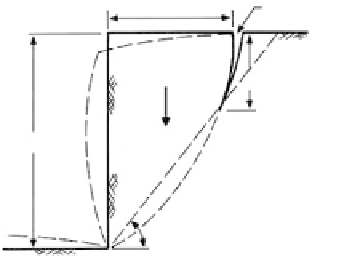Environmental Engineering Reference
In-Depth Information
w
N
=
w
cos
H
R
F
c
L
w
sin
90
−
cL
i
w
90 +
R
−
FIGURE 9.70
Culmann's simple wedge in clayey soil.
Force diagram
slope toe, shear strength is constant along the failure surface in a homogeneous section,
and there are no seepage forces. In practice, seepage forces are applied as in Equation 9.9.
The solution is generally considered to yield reasonable results in slopes that are vertical
or nearly so, and is used commonly in Brazil to analyze forces to be resisted by anchored
curtain walls (see
Section 9.4.6)
.
The solution requires finding the critical failure surface
given by
θ
cr
(i
φ
)/2
(9.11)
FS
[
cL
(
W
cos
θ
) tan
φ
]/
W
sin
θ
(9.12)
where
W
1/2
γ
t
LH
cosec
i
sin (
i
θ
), with
H
max
4
c
(sin
i
)(cos
φ
)/
γ
t
[1- cos (
i
φ
)]
(9.13)
Case 6
: Critical height and tension crack in clay (Figure 9.71). The critical height
H
cr
is
defined as the maximum height at which a slope can stand before the state of tension,
which develops as the slope yields, is relieved by tension cracks. Terzaghi (1943) gave the
critical height in terms of total soil weight, having concluded that the tension crack would
reach to one half the critical height, as
H
'
cr
(2.67
c
/
γ
t
) tan (45°
φ
/2)
(9.14)
b = 0.4
−
0.5H
Tension crack
z
c
z
c
2
c
/
W
H
= 45 +
/2
FIGURE 9.71
Critical height of a vertical slope in clay and the tension crack.





